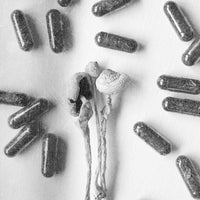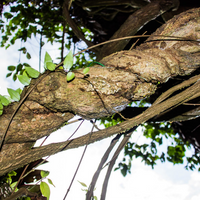This story was originally published by DoubleBlind Mag, a media company and educational platform at the forefront of the psychedelic movement. DoubleBlind is teaching thousands of students around the world how to grow mushrooms right at home. Both of their online courses come with video lessons and written guides, plus access to a private online community with expert mycologists and other students who will support you throughout the grow process. There’s no better time to take your health into your own hands. Join the movement here.
In 1998 the famous mycologist Paul Stamets gave a lecture, explaining how his interest in psychedelic mushrooms served as the gateway that led him into the study of general mycology and its broader applications to environmental remediation and medicinal use. In his personal life, Stamets credits an experience on shrooms (stuck up in a tree during a thunderstorm, as one does) as the catalyst that allowed him to overcome his speech impediment at the age of 17. Indeed, many of us, like Stamets, can attest to the monumental impact psychedelic experiences have had on our lives, our beliefs, and our personalities.
Synthetic psilocybin is only legally accessible to those participating in research at universities like Johns Hopkins and Imperial College London. Historically and today, those seeking out biological sources of psilocybin have three options:
- Foraging for wild species (mostly belonging to the genus Psilocybe and Panaeolus)
- Home cultivation (usually Psilocybe cubensis, though other species are possible)
- Obtaining mushrooms via sale or gift from someone who has done either option one or two
With magic mushrooms containing a number of other potentially psychoactive compounds, such as baeocystin, norbaeocystin and norpsilocin (all of which are present in wild and home-cultivated Psilocybe cubensis, as well as a wide variety of other magic mushroom species), the experience of eating them may not be directly comparable to the single source synthetic psilocybin used in clinical trials; however, there is likely considerable overlap in effect. With growing interest in psychedelics among the academic, pharmaceutical, and civilian sectors, many have voiced concerns around how to ensure equitable and fair access to psychedelics in future.
One way to ensure access is for individuals to become psychedelically self-sufficient by growing psilocybin mushrooms at home. While under federal law, such activity is currently illegal—with Denver, Oakland and Santa Cruz all having decriminalized psilocybin mushrooms—the possibility of legal home cultivation for personal use may be just over the horizon.
Although the prospect of home cultivation may sound daunting, with a little knowledge the process is fairly simple. Here, we’ll make some cases as to why growing your own can save both money and hassle; we’ll also explore the less tangible benefits of personal empowerment and the potential to build community.
Cost
If you’re buying magic mushrooms in the United States, the cost is about $35 per eighth of an ounce (or $10 per gram). In Canada, where the first magic mushroom dispensaries are opening (though still not technically legal yet), those suffering from conditions such as depression, anxiety and cluster headaches can register to receive encapsulated microdoses of magic mushrooms at an even higher price per gram than those buying illicitly in the United States.
By contrast, for $15-$20 you can purchase magic mushroom spores (the mycological equivalent to cannabis seeds) and with the right know-how and a few easily sourced (or, indeed, home-built) pieces of equipment, you could potentially produce well over 100 times the amount of mushrooms you could buy for the same price. Of course, there are additional set-up costs (both in terms of money and time), as well as a level of risk, but some underground growers have reduced these drawbacks by spreading them between a group of like-minded and trusted individuals, effectively setting up self-sufficient magic mushroom collectives.
Safety and Peace of Mind
Thanks to past regressive drug laws, we’ve never had a great time interacting with drug dealers. From the old-school methods of furtively hanging around waiting for a vague text, to the complicated-to-set-up and nail-biting wait of ordering via the dark web, the anxiety levels that may accompany these methods hardly mesh with the idea of a carefully crafted “set and setting” required for optimal psychedelic use. Beyond that, although mushrooms are easy to recognize, there’s always the risk that your dealer has done a bad job of preparing them, or is simply trying to move some old stock that has lost all of its potency. By growing for yourself, you remove any of these concerns and reward yourself with the peace of mind of consuming something that you’ve been in full control of producing.
What about Foraging?
In the Northern United States and Canada, there are an estimated 22 wild-growing hallucinogenic species. If we extend the region to the Americas as a whole, the number increases to over 70. The broad distribution of these species would seem to suggest that foraging might be a suitable alternative to home cultivation. However, when it comes to psychedelics of plant, fungal or animal origin (such as MDMA, LSD, or 5-MeO-DMT just to name a few), the increased interest in such substances brings additional concerns over whether the natural habitats and human communities in which they grow will be respected by a new generation of psychedelic bioprospectors.
Although we’ve engaged in a fair few fungal foraging trips ourselves, we’ve taken the time to gain an understanding of both the ecology and ethics of such actions over many years—and it’s still not something we do very often. The same respect for nature applies when foraging for any wild species: Never take more than you require, and if you require more than there is, don’t take at all.
Foraging for psychedelic fungi takes a lot of understanding, practice, and confidence in your own abilities (including the ability to decipher deadly lookalikes). Though it is possible to learn with the help of more experienced foragers, home cultivation is definitely a safer route for those starting out.
Self-Sufficiency and our Connection to Nature
Before Michael Pollan published the widely read How to Change your Mind, he was a prolific food writer. Our attitudes toward psychedelics run parallel to his attitudes toward food, which include themes around the power of self sufficiency; reconnecting with process and tradition; building community; and empowering others.
With the growing potential for the psychedelic supply chain to be modeled after that of cannabis, the choice to hand over production to large-scale professional grow operations threatens psychedelics with becoming yet another commodity—rendering ourselves as passive consumers in the process. In addition, under the current legal framework, we have to ask ourselves whether communities that have historically used psychedelics as part of their cultural traditions should be bound to new ideas of legislative approval or FDA breakthrough therapy designation.
In a more secular sense, it can be argued that these historical cultural traditions apply in the United States as well. During her PhD studies, Dr. Joanna Steinhardt found that many amateur American mycologists were introduced to the field through the cultivation of magic mushrooms, echoing Stamets’ testimonial. This has led to the formation of alliances of like-minded individuals outside of institutionalized academic and corporate settings—focused not only on mycology and cultivation, but also across themes like ecological preservation, sustainability, and non-hierarchical collective organization.
Such stories are becoming increasingly common as people seek to find alternative ways of living under capitalism. Mushroom growing (magic or otherwise) finds itself in a cluster of related DIY activities that seek to empower people out of the reliance on producer-consumer economics—including pursuits such as permaculture, foraging, beekeeping, fermentation, and homebrewing.
Although the financial benefits are obvious, by actively engaging with the process of growing shrooms we may find it’s possible to unlock something greater within ourselves, allowing us to gain not only a deeper appreciation for the biological, chemical, and cultural contexts from which psilocybin and its associated alkaloids are derived, but also the potential to form a deeper connection with community, nature, and our place in the world.




